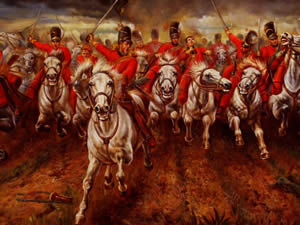Cavalry

The Scots Greys in full gallop at Waterloo
It is clear that cavalry played a very important part in the outcome of the battle. On both sides, poor command of the cavalry resulted in them being utilised to less than their full potential. In the 18th and 19th Centuries, cavalry were considered to be the elite of an army, generally being populated from the aristocratic classes, and as such, discipline would appear to have been a problem. The initial success of Uxbridge and his cavalry was undermined by poor discipline. This gung-ho attitude seems to have been mirrored by the French cavalry, many of whom seem to have joined Ney's charge of their own free will.
A common misconception is that a cavalry charge was conducted at full speed from start to finish. In reality, strict guidelines were laid down as to the manoeuvre; a trot became a canter and then a gallop and only within 50 yards of the enemy would full speed be reached. This not only prevented the horses from becoming exhausted before they reached their target, but also helped to maintain control and order and prevented gaps from appearing in the ranks.
Around this time, cavalry were armed with an assortment of sabres, pistols, carbine and lances. Of the firearms, pistols were intended for use in a melee whereas carbines were better employed at a standstill or dismounted. In most of the armies, heavy cavalry tended to wear some sort of body armour to protect against pistol shot and attack by sword and bayonet.